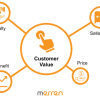A successful customer feedback program depends on how well we define objectives and goals initially. The main crux is to provide memorable user experience across the customer journey and build ways to reinforce customer retention. Planning in advance is a great way to have an overall successful program. In this blog, we will explore all key elements like defining clear objectives and goals, choosing appropriate feedback collection methods, analyzing feedback effectively, and implementing actionable insights. We’ll also cover different types of customer feedback including transactional, relational, solicited and unsolicited. We’ll discuss choosing survey questions, survey frequency and distribution methods. Finally, to implement change based on customer feedback we’ll cover identifying trends and themes, prioritizing changes based on impact and effort and communicating changes to customers. So let’s get started!
Why is a customer feedback program important?
Successful businesses understand the value of customer feedback in improving their operations and increasing customer satisfaction. A well-designed survey program equips companies to collect valuable information directly from their clients. This can be used to make data-driven decisions for better products and services. By leveraging this information, businesses can make necessary changes and improvements to stay competitive in a rapidly changing market. In addition, customers appreciate being heard and having their opinions valued, leading to increased loyalty and satisfaction. Ultimately, designing an effective customer feedback program is essential for any business looking to improve its bottom line.
Key Elements of a Successful Customer Feedback Program
Introducing a successful customer feedback program involves incorporating several key elements. Firstly, there should be clear objectives to determine the desired outcomes of the program. This includes identifying what type of feedback is necessary and how it will be administered. Next, appropriate channels for gathering feedback should be chosen, depending on factors such as the target audience and the nature of the business. Timely responses to customer feedback are crucial and can help build trust and loyalty. Regular evaluations of the program’s effectiveness, combined with transparent communication with customers, will keep the program relevant and valuable.
Clear Objectives and Goals
Before starting to create any customer satisfaction survey, establish clear and concise goals and objectives. This will eliminate decision fatigue for respondents, help businesses allocate resources better and create a streamlined method of collecting feedback efficiently. A clear survey goal can bring better results across the consumer base. While objectives can also determine at which touchpoints can a survey be suitable for launch.
Clear goals also include being specific about why you need certain metrics such as a net promoter score or NPS survey, customer satisfaction score (CSAT) scale or understanding when you should deploy the customer effort score (CES) survey.
Choosing Appropriate Feedback Collection Methods
The choice of feedback collection method will depend on your target audience and the type of feedback you want to collect. Surveys are great for collecting quantitative data while focus groups provide qualitative insights. Social listening via social media platforms such as Twitter, Facebook can help you track customer sentiment and identify trends in real-time.
Choose mediums that are real time and are easily accessed by your customers. This includes messenger based surveys (Whatsapp and Meta messenger) and dynamic AMP email surveys. By selecting the appropriate channels, you can get a high response rate, unlock rich user insights and can attend to feedback loop faster.

Analyzing Feedback Effectively
Analyzing customer feedback involves collecting data from various sources, including live chat bot surveys, social media platforms, in-app surveys and customer support interactions. One effective way to analyze feedback is to use sentiment analysis tools that categorize feedback into positive, negative, or neutral categories. Using this segmentation, you can identify unhappy customers or detractors (as mentioned on NPS scales), upsell and cross sell to promoters (or happy customers).
Data analytics is a crucial part of customer feedback strategy. Merren has a robust dashboard that comes with data analysis tools. On receiving feedback. every response can be segmented as per filters set by the clients. It’s important to regularly review your feedback analysis methods to ensure they align with your business strategy and customer needs. By effectively analyzing customer feedback, you can make informed decisions that benefit both your customers and your business.
Actionable Insights and Implementation
Survey results that bring a high response rate will often be the one that was effectively designed. To get actionable data, the market research team has to curate a feedback form that will bring genuine responses. Often, a lengthy survey will skew responses or bring inauthentic data. We want to avoid this as much.
A successful customer feedback program is one that provides actionable insights that can be implemented to improve the customer experience. It is not just enough to bring insights that are good for the dashboard. Implementation is the key to overall customer success. Implementation involves attending to negative feedback, creating upgraded customer support for patrons, offering feasible solutions to existing problems and enhancing products and services overall.
Types of Customer Feedback
When it comes to gathering customer feedback, there are various methods that businesses can use to gain insights into how their customers feel about their products or services. Surveys are a popular option as they allow companies to gather structured feedback on specific aspects of the customer experience. Interviews, focus groups, and social media monitoring are other common techniques as well. Each method offers its own unique benefits and drawbacks; understanding which approach is best for your business depends on your objectives and target audience.
Transactional Feedback
Transactional feedback refers to feedback provided in response to a specific transaction or interaction between individuals or entities. It is typically given immediately after the completion of a transaction, such as a purchase, a meeting, or a customer service interaction. It is focused on evaluation specific experiences and it is evaluated on the following:
Customer satisfaction measurement: This can gauge customer satisfaction and help organizations understand how well they meet customer expectations. By collecting feedback after each transaction, organisation can identify patterns and trends in customer satisfaction and take prompt actions to improve their services.
Issue resolution: Transactional feedback can resolve any immediate issues or concerns raised during the transaction. By addressing customer complaints or suggestions promptly, organizations can demonstrate their commitment to customer service and strengthen customer relationships.
Continuous improvement: By analyzing transactional feedback over time, organizations can identify recurring issues or areas where improvement is needed. All customer insights can be used to refine internal processes, enhance products or services, and ultimately provide a better overall experience for users.

Relational Feedback
Relational feedback focuses on interpersonal dynamics a business shares with a customer. It is more than just seeking feedback to improve customer services. It is a type of feedback that aims to enhance and improve the way people interact and collaborate with each other.
Here are some of the key pointers that can denote relational feedback:
Customer review and ratings: Customers love to share candid feedback. We can witness this via multiple online reviews on google business listings. Monitoring these reviews and offering feasible solutions for unhappy customer is the way to augment customer loyalty and satisfaction.
Service and product feedback: Businesses often use surveys, questionnaires, or feedback forms to collect information directly from customers. This feedback can cover various aspects such as product quality, customer service, user experience, pricing, and overall satisfaction. It provides valuable insights into customer preferences, needs, and areas for improvement.
Offering communication channels: For immediate resolution, businesses offer live chat customer support, toll free phone number, email assistance , instant twitter support just so the customers can reach out to the brands and seek resolution for issues. Using these mediums, the teams can offer quick and personalized support.

Solicited Feedback
Solicited feedback in this context, refers to the intentional and proactive collection of opinions, suggestions, and comments from customers or clients by an organization. Solicited feedback can be obtained through several methods, including surveys, focus groups, customer interviews, suggestion boxes, online feedback forms, and social media polls. These feedback mechanisms allow organizations to gauge customer satisfaction, identify areas for improvement, and make informed business decisions.
Continuous improvement: In this method, organisations collect feedback at certain time intervals to gauge if the brand’s products and services can continue filling the need gap for the users. This is also a way to measure the customer satisfaction levels over time at certain milestones.
Structured feedback: Solicited feedback often involves structured questions or formats, such as multiple-choice questions, rating scales, or open-ended prompts. This helps organizations collect standardized data and allows for easier analysis and comparison.
Unsolicited Feedback
Unsolicited feedback can be a valuable source of information for businesses looking to improve their products or services. In this method, users voluntarily share feedback based on their own experiences, observations, or opinions regarding the products, services, or overall performance of the business. There are plenty of online reviews, social media testimonials, direct emails that make up a bulk part of unsolicited feedback. Since they are honest in nature, organisations can assess different customers based on the feedback metric to gauge if a certain service/product could help them or deter them.
Responding to unsolicited feedback demonstrates that the business values its customers’ opinions and is committed to addressing their concerns or suggestions. This can foster customer loyalty, improve the overall customer experience.
How to Create an Effective Customer Feedback Survey
An effective customer strategy can come after a business can define its goals and aspirations explicitly. There are a few pointers to note here.. By following these practices, businesses can create effective surveys that yield actionable insights for decision-making.
Choosing Survey Questions
Your questions should be specific and relevant to your business, while also being easy for customers to understand and provide valuable insights. Consider using a mix of open-ended and closed-ended questions to gather both qualitative and quantitative data. Demographic questions can also be included to better understand the characteristics of your customer base. Always keep in mind the purpose of your survey, and tailor your questions accordingly.
Survey Frequency
Determining the frequency of your customer feedback surveys is crucial to ensure that you are gathering enough data to make informed decisions without overwhelming your customers with too many surveys. The frequency of your surveys will depend on the nature of your business and the type of feedback you are seeking. For example, if you are launching a new product or service, you may want to send out a survey after the initial release and then periodically thereafter. On the other hand, if you are looking for ongoing feedback on customer service, you may want to send out surveys at regular intervals, such as every six months. By striking a balance, you are not overwhelming customers.

Survey Distribution Methods
How you administer a survey will also determine your overall response rate. Some common methods are email surveys, in-app surveys, and website pop up feedback forms. However, to get genuine responses, one can launch surveys via real time mediums of Whatsapp, Meta messenger, launch chat bot surveys, opt for SMS/RCS mediums and bring in interactive dynamic AMP emails surveys.
It’s important to choose the distribution method that best fits your target audience and business goals. For instance, if your target audience is active on social media, then using social media surveys would be a more effective option than email surveys. Similarly, if your customers are mostly visiting your website to make purchases or explore products, chat-bot surveys are a good technique to collect instant responses.
Effective Feedback Analysis Techniques
Tracking progress over time is also essential in measuring the effectiveness of improvements made. Utilizing technology can streamline the analysis process and gather data more efficiently. For a comprehensive approach, both quantitative and qualitative analysis should be used to gain a well-rounded understanding of customer feedback.
Quantitative Analysis
Quantitative analysis involves analyzing numerical data using statistical methods to draw conclusions and identify patterns. Surveys, polls, and questionnaires are some common techniques used in quantitative analysis. To ensure statistically significant conclusions, it’s important to have a large enough sample size in your survey. The insights gained through quantitative analysis can help businesses identify areas for improvement and track very specific progress from different metrics. By implementing effective quantitative analysis techniques, companies can better understand their customers’ needs and make data-driven decisions.
Qualitative Analysis
Qualitative analysis provides a unique and valuable perspective when it comes to customer feedback. By analyzing unstructured data like open-ended survey responses, customer comments, businesses can have rich media insights, customer emotions that may not be captured by quantitative data alone. This type of analysis is crucial for identifying emerging trends, understanding the root cause of certain issues and providing context to numerical data. Techniques such as content analysis, thematic analysis and sentiment analysis can help businesses glean rich insights from qualitative feedback. When paired with quantitative analysis, qualitative insights can provide a holistic view of customer feedback and guide meaningful improvements to products or services.
Implementing Change Based on Customer Feedback
When a business conducts a follow-up on changes implemented, customers can be reassured that its organization is interested in creating a seamless customer journey for every user. The customer feedback surveys make more sense if brands follow through, implement changes and create a better ecosystem for their client base. By communicating with customers throughout the process, companies can keep them informed and engaged in the changes being made. Continuously monitoring and evaluating the effectiveness of these changes will help ensure that they are having a positive impact on the overall customer experience.
Identifying Trends and Themes
Analyzing customer feedback can uncover insights and trends that may not be immediately apparent. By categorizing feedback into themes and sub-themes, businesses can streamline the analysis process and quickly identify areas of concern or opportunity. Once these themes are identified, one can prioritize them based on their potential impact on the business. A regular review of trends can update the feedback program to ensure continued success.
Prioritizing Changes based on Impact and Effort
Assessing the potential impact of each change on customer satisfaction, retention, and loyalty is crucial in determining priorities. You should also consider the effort required to implement each change, including time, resources, and costs. By focusing on impactful and effort-oriented changes, you can ensure that you’re making the most of your customer feedback program and delivering valuable improvements to your customers.
Communicating Changes to Customers
When communicating changes to customers, it’s important to include how the changes will benefit them and encourage further feedback. A system to track the effectiveness of changes will help you monitor progress and adjust priorities as needed.
Best Practices for a Successful Customer Feedback Program
Successful feedback programs require a strategy that aligns with the objectives of your business. One of the best practices is to define clear goals and objectives for your feedback program. Encouraging honest and constructive feedback by offering incentives or rewards are some of the best practices. Use these insights to make meaningful changes to your products or services, communicate with consumers regularly, and involve employees in the feedback process.
Make Feedback Easy to Provide
Offer multiple channels for patrons to give feedback, such as interactive email, online review portals, messenger based feedback systems and live chats on websites. Keep the feedback process short and simple with clear instructions on how to provide feedback. Consider using a rewards program or other incentives to encourage customers to provide feedback.

Act on Feedback Quickly
Acting on feedback quickly demonstrates that you value your customers’ opinions and are committed to improving their experience. Promptly acknowledging feedback within 24-48 hours, even if it’s just a simple acknowledgement, can go a long way in building trust and loyalty. Prioritizing feedback based on its impact on customer satisfaction and loyalty is crucial. Develop a comprehensive plan that addresses recurring issues and ensure that appropriate actions are taken to fix them.
Involve Employees in the Feedback Process
Employees are a valuable source of information as they interact with consumers daily and can provide insightful observations. They play a pivotal role in identifying the areas for improvement. Involving them also helps them feel more engaged with their work and motivated to improve the company’s overall performance. Providing training and support can help employees effectively gather and analyze respondent feedback, resulting in better insights into the customer experience.
Conclusion
A successful customer feedback program is a tool that can help businesses of all sizes stay competitive, improve customer satisfaction, and drive growth. To create a successful feedback program, you must set clear objectives, choose appropriate feedback collection methods, analyze feedback effectively, and implement actionable insights.
To understand how you can attain qualitative and quantitative insights, sign up for a 14 day free trial here.





